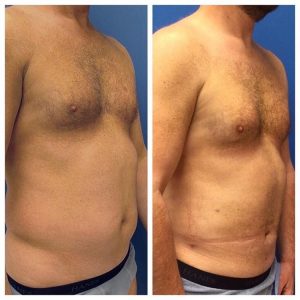Liposuction
What is Liposuction?
Liposuction, also known as lipoplasty or suction lipectomy, involves reducing patient’s unwanted fat bulges or pockets using a suction apparatus, when diet and exercise do not work. Liposuction is used to sculpt and shape the curves of a patient’s body to their desired outcome, by permanently removing fat cells. The most common sites for liposuction include the chin, neck, arms, abdomen, thighs, calves, ankles, and buttocks.
Technique:
While there are many types of liposuction including traditional, power – assisted, laser, ultrasound, water-jet, and radio frequency, our surgeons prefer the traditional method. Traditional liposuction involves the use of metal tubes, called cannulas, to remove fat from areas of the body. This option can be used to sculpt a more ideal shape, making the removal of fat more proportional. The traditional method of liposuction is best if you have localized fat deposits with good skin tone, being most effective in areas of less fibrous tissue. The benefits of traditional liposuction include that this form of liposuction is backed by many years of research proving its safety and efficacy.
This surgical procedure entails small incisions made in, or near, the designated area. A solution, called tumescent fluid, composed of a combination of saline, lidocaine (a local anesthetic), and epinephrine, is injected into the designated area to break up the fat cells and allow for easy removal with the cannula. The fat is then suction out of the troublesome area, and the small incisions are closed using sutures.
Surgery:
This surgical procedure is typically performed on an outpatient basis, in our Joint Commission certified operating suite. Surgery lasts on average of 1-2 hours, and then patients are discharged home that same day. Patients who undergo breast augmentation will follow up in our office 1-3 days post operatively.
Things to know:
- You will have to wear a compression garment for 8 weeks.
- You may begin showering in 48 hours after surgery. When showering, wash all areas with soap and water, and pat dry with a towel. It is important that you do not submerge your surgical incision in water (i.e. no bath tubs, swimming pools, etc.).
- Sutures will be absorbable. Follow up appointments will typically be scheduled in weekly and then two-week intervals. You may begin scar massage and use of scar creams approximately 3 weeks after surgery.
Postoperative restrictions are as follows:
No submerging incision sites (i.e swimming
for a minimum of 3 weeks), no sweat producing exercise for a minimum of 3 weeks, light activity for 2-3 weeks.
Common side effects of liposuction include:
Small scars, swelling and bruising, discomfort to area of liposuction, contour irregularities, numbness, and hyperpigmentation. Scars are rarely visible to someone other than the patient, because incisions are so small. Swelling and bruising are common in the first few days and can last up to 3 weeks. Patients may also feel discomfort in the treatment area; however, you can expect to be up and walking right away. Patient’s can experience contour irregularities as the fat settles, but this can improve with massage, topical creams or ultrasound treatments. In some instances, patients may experience temporary numbness from disruption of the small nerves lying below the skin. However, in very rare situations, numbness may be permanent. Lastly, hyperpigmentation will occasionally occur in treatment areas and last for months.
Results:
Patients can expect to see a noticeable difference in treatment area 2- 3 weeks after surgery. 6 months post operatively patients can except to see more final results, but these can continue to improve over the next 6 months. Once fat cells are removed in the treated area they will not grow back; however, it is still possible to gain fat in treated areas if new figure is not maintained with healthy lifestyle changes including proper weight management with diet and exercise.

